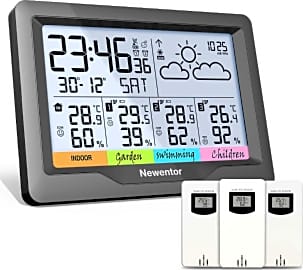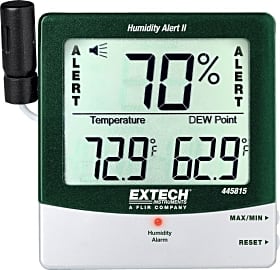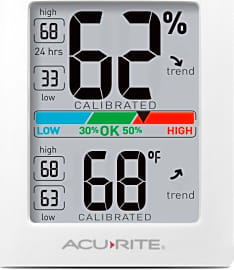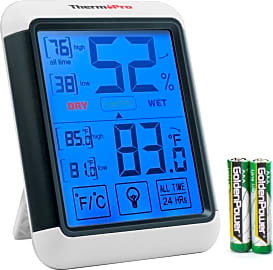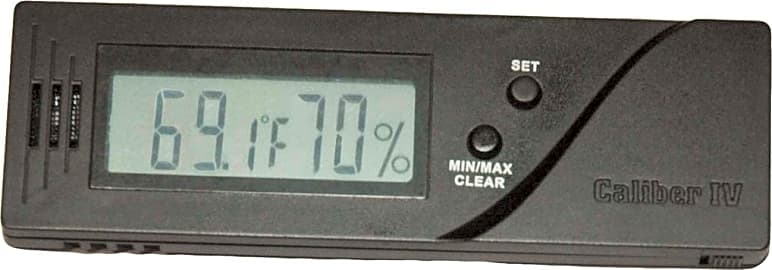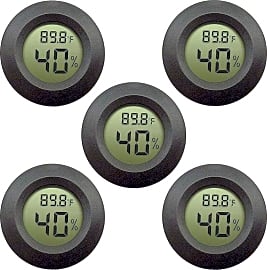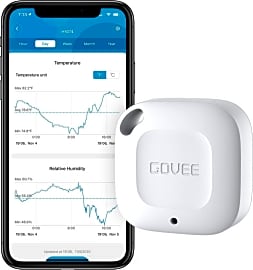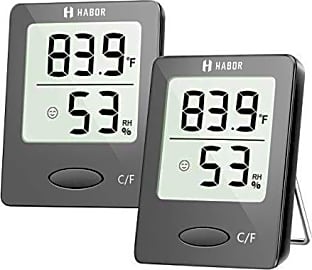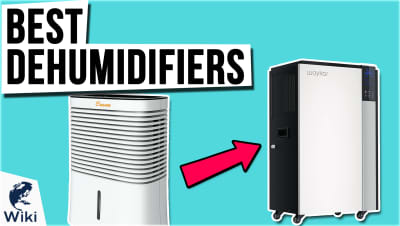The 10 Best Humidity Monitors

This wiki has been updated 42 times since it was first published in June of 2015. Ideal for gardeners who need to keep their flowers and plants at precise levels, for reducing the risk of mold in potentially damp basements, and for maintaining comfortable room conditions, these humidity monitors provide accurate tracking of moisture in the atmosphere. We've included both plugin and battery-powered models, as well as units that also measure the current temperature. When users buy our independently chosen editorial selections, we may earn commissions to help fund the Wiki.
Editor's Notes
November 12, 2020:
During this round of updates, the Ambient Weather Monitor was removed due to availability issues, and we decided on doing away with the AcuRite Indoor, in order to make room for some new, high-end additions. We also ended up ending the Amprobe Temperature Meter’s residency on this page, recognizing that we maintain a separate page for psycrometers, aimed at HVAC technicians and other industry professionals, and determining that this list works best when it’s focused on long-term monitoring solutions that are suitable for the average homeowner.
For users who notice that our list still includes the ThermoPro TP55, even though the ThermoPro TP52 is now being presented as a newer version, it’s worth noting that, although the display on the TP52 does look quite slick, it’s actually a bit smaller than the TP55’s, and displays less data on its home screen. With their prices being virtually the same, we thought it made the most sense to let the TP55 stay.
Our new additions this time around are the Newentor Weather Station — which comes with three outdoor sensors, allowing you to monitor a total of four locations through its controller, simultaneously; the Smartro SC62 — which only comes with one sensor, but can accommodate up to three if you buy extras separately, and features a smart-looking color display; and the Govee Mini — which has no screen, but can easily be monitored via app, thank to its 328-foot, line-of-sight Bluetooth range.
If you’ve already started shopping in this category, then you might have noticed several options similar to the Govee Mini that feature Wi-Fi connectivity, making it possible to monitor them from virtually anywhere. We considered several of these options during these updates, but the problem we had with them came down to price. Whilst their functionality is clearly superior to the Mini, in at least one respect, their cost tends to be between three and eight times more. You could argue that they’re worth the money, but with the Govee WiFi Monitor – which features not only internet connectivity, but also a simple, integrated display – offered for a comparable, and sometimes significantly more affordable cost – it was hard for us to imagine many situations where our users would be better served by an expensive, screenless option.
December 04, 2019:
We added two new offerings to our rankings during this round of updates. The first option is the Govee WiFi Monitor. It won our attention with its attractive design, Bluetooth functionality and Amazon Alexa compatibility. It’s quite an accurate option, as well. Just be careful if this is the route you’re thinking of going, because it seems as if it might not support 5G Wi-Fi systems.
The second option is the Eeekit Black Round, a very simple model that’s equally affordable and sold in packs of three or five. The way it caught our eye, in a category full of meters with awkward mounting provisions, is with its slick design that makes for easy recessed mounting. The only tools you’ll require are a 42-millimeter hole saw and power drill, and you can have this unit flush mounted to your drywall in no time – possibly right next to your hallway thermostat for comparative analysis.
If humidity is an ongoing problem in your home, indoor garden or personal brewery, you might want to take a few minutes to peruse our rankings for best dehumidifiers. We even have separate pages dedicated to units that can handle a whole house and options with pump-based designs.
On the other hand, if dryness is an ongoing thorn in your side, you might want to take a few minutes to review our rankings for best humidifiers. Once again, we maintain a separate page for whole-house offerings, and even an additional wiki for travel-friendly options.
How Modern Humidity Sensors Work
Thermal sensors measure absolute humidity rather than relative humidity.
Humidity simply means the presence of water in the air, and various humidity sensors measure that presence in different ways. Because it is difficult to isolate the water content in the atmosphere, each type of sensor measures some other co-existing quality in the air, like pressure or electrical charge. A capacitive humidity sensor works by monitoring the electrical capacity of a strip of metal oxide. The strip is placed between two electrodes, and when there is a change in atmospheric humidity, the electric charge on the metal oxide alters.
Thermal conductivity sensors are made up of two sensors, one of which sits in dry nitrogen, while the other is exposed to ambient air. The difference between the two sensors’ ability to conduct electricity is an indicator of humidity. Thermal sensors measure absolute humidity rather than relative humidity. Relative humidity is the ratio of water in the air to the amount of water that could be in the air at the current temperature. Relative humidity plays a large role in how comfortable humans feel in certain climates.
Resistive humidity sensors use the ions in salt to achieve their measurements. When there is a change in humidity, there is an adjustment in the resistance of the electrodes on either side of the salt. Resistive varieties sometimes use conductive polymers instead of salt; regardless of the material involved in measuring electrical resistance, these models typically need to be paired with a temperature sensor to achieve accurate results.
Gravimetric sensors use mass to measure humidity. These sensors compare the mass of an atmospheric air sample to that of an equal volume of dry air. Weather experts consider this the most accurate method of determining humidity. The United States, The United Kingdom, The European Union and Japan established national standards based on gravimetric measurements.
What Can Happen When Humidity Is Too High Or Too Low
Humidity can affect human comfort, which is one of the reasons the weather report lists it each day, but it can also do much more than that. Proper humidity levels in greenhouses are crucial to ensuring optimal growing conditions for crops. Most plants hold and move water through their tissues; it is taken up by the roots and sent out through the leaves into the air. This process — called transpiration — is important to cooling a plant down. When humidity levels in the air are too high, transpiration happens slowly and that can harm the plant.
When humidity rises, the wood in items like violins and guitars expands.
Musicians often use humidity sensors to monitor the environment of their instrument. When humidity rises, the wood in items like violins and guitars expands. During times of high humidity, musicians find it difficult to tune their instruments because the wood around the pegs has swelled, making them too tight. Reversely, if humidity levels drop, the wood of an instrument can shrink, causing tuning pegs to become too loose, and difficult to keep in place.
Humidity is important in spas, gyms and country clubs because these venues typically contain saunas. While the temperature inside of a sauna can rise to 90 degrees, it remains comfortable because the humidity levels are kept low. Most people have experienced this phenomenon in natural locations, too; walking through the desert can be more comfortable than traversing a rain forest, even if the temperatures are the same because the latter has high humidity levels. Businesses that operate steam rooms try to keep the humidity levels up to 100 percent inside of these environments, which is why condensation builds up on the walls. Both of these climates — dry and humid — offer health benefits, but only for short periods of time, which is why warnings are posted outside of each, with suggested usage.
Additional Data Found On Humidity Sensors
Modern humidity sensors can report several pieces of information about the environment. Countless systems run through and around your home, interacting with both the climate inside of your walls and outside of them. If they build condensation, retain too much moisture or freeze, they can fail to work properly.
Some sensors display the dew point — the temperature at which water vapor turns into liquid. An instance in which one can observe this happening is when ice on a window melts into water. That water can sink into the window pane, causing the wood in it to expand and warp. Wood warping can cause problems for the structure of a home. Frost point also appears on many sensors and is the temperature at which water vapor in the air turns into ice. Monitoring the frost point can help prevent issues like frozen pipes. Consider a sensor with alarms that alert you when humidity levels are too high or too low.
People who live in highly polluted areas can benefit from sensors that analyze air quality. Some sensors report the carbon dioxide levels in the air, which can help one determine if air conditioning or heating is escaping. A humidity sensor can also be built into an all-in-one weather reporter, which displays daily highs and lows, humidity comfort levels and local forecasts.



